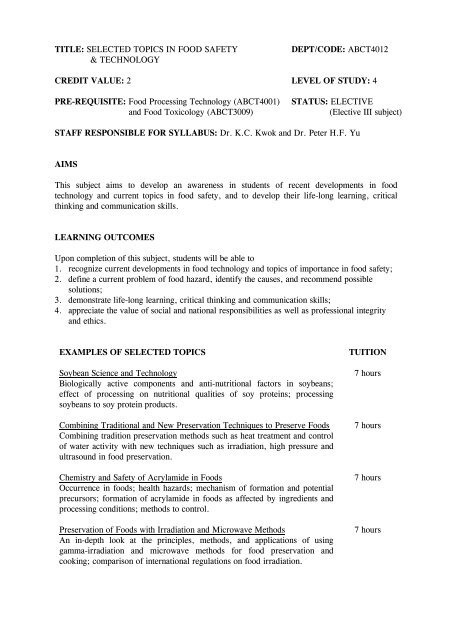ABCT4012
ABCT4012
ABCT4012
You also want an ePaper? Increase the reach of your titles
YUMPU automatically turns print PDFs into web optimized ePapers that Google loves.
TITLE: SELECTED TOPICS IN FOOD SAFETY<br />
& TECHNOLOGY<br />
DEPT/CODE: <strong>ABCT4012</strong><br />
CREDIT VALUE: 2 LEVEL OF STUDY: 4<br />
PRE-REQUISITE: Food Processing Technology (ABCT4001)<br />
and Food Toxicology (ABCT3009)<br />
STATUS: ELECTIVE<br />
(Elective III subject)<br />
STAFF RESPONSIBLE FOR SYLLABUS: Dr. K.C. Kwok and Dr. Peter H.F. Yu<br />
AIMS<br />
This subject aims to develop an awareness in students of recent developments in food<br />
technology and current topics in food safety, and to develop their life-long learning, critical<br />
thinking and communication skills.<br />
LEARNING OUTCOMES<br />
Upon completion of this subject, students will be able to<br />
1. recognize current developments in food technology and topics of importance in food safety;<br />
2. define a current problem of food hazard, identify the causes, and recommend possible<br />
solutions;<br />
3. demonstrate life-long learning, critical thinking and communication skills;<br />
4. appreciate the value of social and national responsibilities as well as professional integrity<br />
and ethics.<br />
EXAMPLES OF SELECTED TOPICS<br />
Soybean Science and Technology<br />
Biologically active components and anti-nutritional factors in soybeans;<br />
effect of processing on nutritional qualities of soy proteins; processing<br />
soybeans to soy protein products.<br />
Combining Traditional and New Preservation Techniques to Preserve Foods<br />
Combining tradition preservation methods such as heat treatment and control<br />
of water activity with new techniques such as irradiation, high pressure and<br />
ultrasound in food preservation.<br />
Chemistry and Safety of Acrylamide in Foods<br />
Occurrence in foods; health hazards; mechanism of formation and potential<br />
precursors; formation of acrylamide in foods as affected by ingredients and<br />
processing conditions; methods to control.<br />
Preservation of Foods with Irradiation and Microwave Methods<br />
An in-depth look at the principles, methods, and applications of using<br />
gamma-irradiation and microwave methods for food preservation and<br />
cooking; comparison of international regulations on food irradiation.<br />
TUITION<br />
7 hours<br />
7 hours<br />
7 hours<br />
7 hours
Marine Biotoxin<br />
Contamination of shellfish and seawater fish with biotoxin from blooms of<br />
algae, puffer fish tetradotoxin and other marine fish that contain toxins;<br />
shellfish poisoning causing paralytic shellfish poisoning (PSP), amnesic<br />
shellfish poisoning (ASP), and neurotoxic shellfish poisoning (NSP).<br />
Diseases in Poultry and Animals<br />
Investigations of some diseases that occur in poultry and animals, such as<br />
avian influenza, Salmonella, mouth and feet disease in pigs, and BSE (Mad<br />
Cow Disease); discussion also on the prevention, testing, and monitoring<br />
programmes.<br />
School Lunch Box Programme<br />
A critical analysis of food poisoning caused by improper handling,<br />
preparation, and storage of school lunch boxes; the responsibility of the<br />
catering service, schools, and teachers.<br />
Total Diet Study<br />
TDS as a tool for risk assessment and control in relation to the chronic<br />
dietary exposures to chemicals across the total diet of a population.<br />
7 hours<br />
7 hours<br />
7 hours<br />
7 hours<br />
TEACHING/LEARNING APPROACH<br />
Four main topics related to current issues in food safety and food technology are selected for<br />
learning in the subject, with 7 hours allocated to each topic. Keynote Lectures are introduced to<br />
students to cover the main theme of the subject matter. Tutorial will form a significant part of<br />
the teaching and learning strategy of this subject, which aim to foster students’ skills in<br />
analytical power, information acquisition, critical thinking, problem-solving and life-long<br />
learning. Through small-group discussions of relevant topics/issues, tutorials can also enhance<br />
students’ communications skills and their awareness of professional integrity, ethics and social<br />
responsibilities.<br />
MODE OF STUDY<br />
Lecture<br />
Tutorial<br />
Total<br />
20 hours<br />
8 hours<br />
28 hours<br />
ASSESSMENT<br />
Examination Continuous Assessment Total<br />
50% 50% 100%
In this subject students will be concerned with current issues in food safety and technology. The<br />
teaching strategy places emphasis on student-centered and self-directed learning. A group miniproject<br />
forms an important part of the continuous assessment. Students will work in groups on<br />
assigned topics. The group performance and the performance of the individual are assessed<br />
through written and oral reports. The study approach, teamwork involvement, quality of<br />
written reports and performance in oral presentation, including communication skills, form the<br />
basis of assessment for the group project. The continuous assessment is also supplemented by<br />
written tests. A final examination is held at the end of semester. Tests and examination are set<br />
and marked in accordance with the identified learning outcomes and assessment criteria.<br />
Students are required to obtain Grade D or above in both the continuous assessment and the<br />
examination.<br />
READING LIST<br />
References<br />
Zeuthen, P. (Ed.) Food Preservation Techniques Woodhead Publishing<br />
2003<br />
Rahman, M.S. (Ed.) Handbook of Food Preservation Marcel Dekker 1999<br />
Hoboken, N.J. Food Safety Handbook Wiley 2003
















